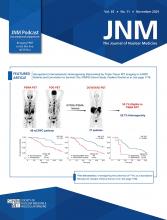Prostate-specific membrane antigen (PSMA) has rapidly been established as a target for prostate cancer management for diagnosis, staging, and image-guided therapy (1,2). Nonetheless, during de novo [99mTc]Tc-PSMA radioguided surgery, it is challenging to assess primary tumor margins. Recently, a solution has been proposed using small-bore 3-dimensional PET/CT (3,4).
Here, we report the case of a de novo prostate cancer patient scheduled for robot-assisted [99mTc]Tc-PSMA-I&S radioguided surgery (531 MBq intravenously the day before surgery). The NCI-AvL institutional review board approved this study (IRBdm24-249). The morning of surgery, preoperative SPECT/CT (Fig. 1A) displayed elevated tracer uptake within the primary tumor site and in a suspected lymph node. After resection and without further tissue preparation, the prostate was scanned with an industrial 3-dimensional surface scanner (light detection and ranging [LiDAR]) and freehand SPECT (5). To allow synchronization of the signal and the detector orientation, the latter approach used an optically tracked crystal gamma camera (Fig. 1B). A 3-mm pixel spacing, an iterative reconstruction algorithm (maximum-likelihood expectation maximization, 20 iterations), and a 3-mm gaussian filter were used. The LiDAR scan and the molecular freehand [99mTc]Tc-PSMA SPECT, approximately taking 3 min each, were automatically fused via an asymmetrical refence tracker. Visualization and analysis occurred in 3DSlicer software, taking 3–4 min for the elaborate image display, providing a hybrid scan in either augmented or virtual reality (Fig. 1C). The prostate specimen scan could anatomically be related to the excised prostate tissue (Fig. 1D) and the [99mTc]Tc-PSMA uptake related to SPECT/CT findings (Fig. 1A). With SPECT intensity thresholds set at 16% of the maximum signal, margins did not display tumor involvement (Fig. 1D); at histopathology, bilateral adenocarcinoma was found in the prostate extending to extraprostatic tissue (posterolateral left region) and the left seminal vesicle (Gleason score of 4 + 5 = 9).
(A) [99mTc]Tc-PSMA SPECT/CT axial images showing focal bilateral uptake in prostate, more intense on the left (yellow arrows), and in left deep obturator node (red arrow). (B) Back-table specimen scanning setup, highlighting specimen tray with integrated optical reference trackers, 3-dimensional surface scanner (0.5-mm resolution, Artec Eva [Artec3D], LiDAR), and hand-held γ-camera (CrystalCam [Crystal Photonics]) combined with DeclipseSPECT (SurgicEye). (C) Hybrid freehand SPECT/LiDAR specimen scans indicating 2 hotspots in prostate (arrows). (D) Correlated images showing (top) histopathology of primary tumor (prostate cancer) and (bottom) excised prostate tissue.
This case shows that hybrid freehand SPECT/LiDAR prostate cancer specimen imaging is feasible, thus providing a low-cost and low–radiation-dose alternative to postoperative PET scanning. Further studies are needed to define optimal threshold levels and to investigate how specimen imaging impacts the surgical procedure.
DISCLOSURE
This research was supported by a Dutch Research Council NWO-TTW-VICI grant (TTW 16141), a NWO KICH grant (KICH1.ST03.21.030), and a KWF PPS grant 2022-PPS-1/14852. No other potential conflict of interest relevant to this article was reported.
Footnotes
Published online Oct. 3, 2024.
- © 2024 by the Society of Nuclear Medicine and Molecular Imaging.
- Received for publication June 17, 2024.
- Accepted for publication September 19, 2024.








